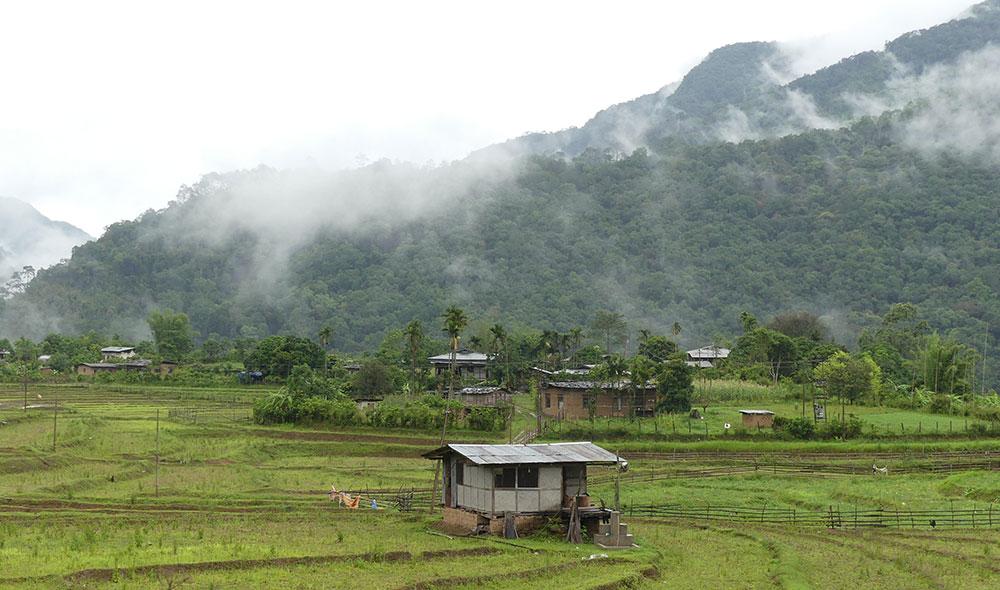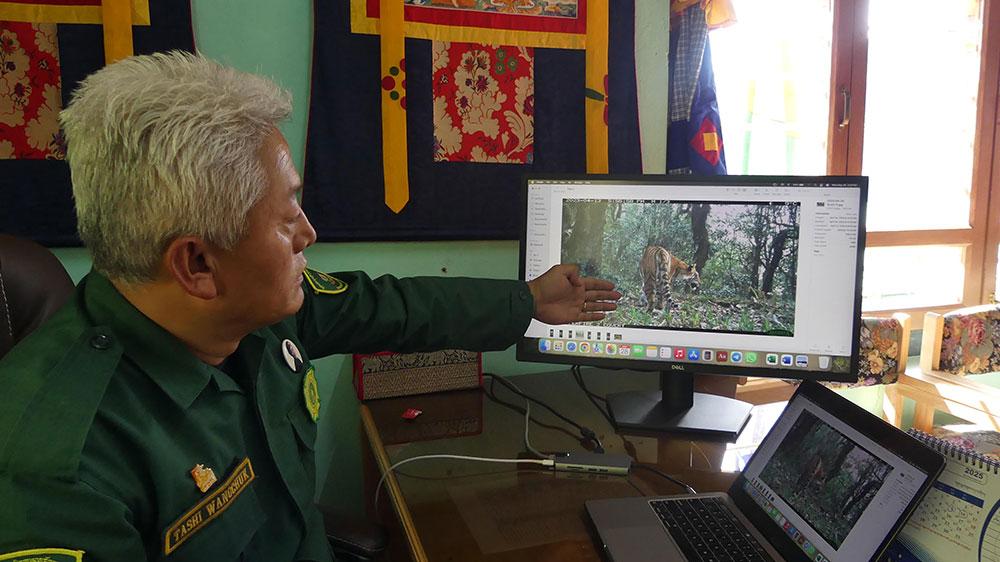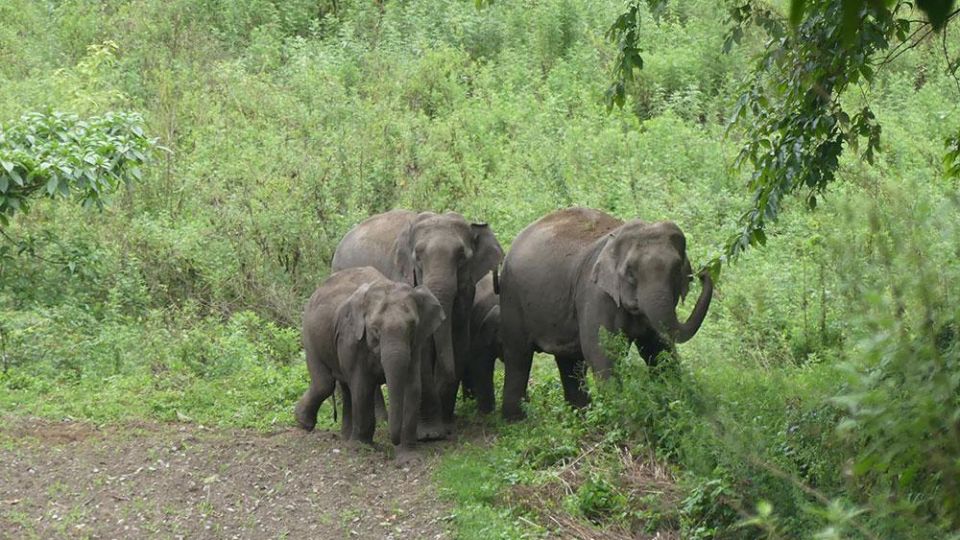June 19, 2025
THIMPHU – At daybreak in Berti village, 65-year-old Wangpo walks the perimeter of his maize field, searching for signs of fresh damage. The evidence is unmistakable—flattened stalks and circular impressions pressed into the damp soil.
“They came again last night,” he says, pointing at the ruined crop. “If I don’t stay up to guard tonight, there will be greater destruction.”
For Wangpo and hundreds of subsistence farmers in Zhemgang, wildlife is no longer confined to the forests. It has spilled into their fields, backyards, and even doorsteps, threatening food security, safety, and livelihoods.

A biodiversity treasure, a daily struggle
Zhemgang Dzongkhag borders three national parks—Royal Manas, Jigme Singye Wangchuck, and Phrumsengla—and contains nearly 90 percent of the Biological Corridor 4 (BC4) that links these protected areas. With more than 52 percent of its land area under conservation and a forest cover of 93.89 percent, Zhemgang is one of Bhutan’s richest biodiversity zones.
This ecological wealth shelters endangered species like tigers and the White-bellied Heron. But for local farmers, it comes at a high cost. Many spend sleepless nights banging tins or lighting fires in an effort to protect their crops, often to little avail.
“We stopped growing maize for three years because of nightly raids,” says Yegha Wangmo. “Even with deterrents—banging tins, lighting fires—the damage never stopped.”
Livestock losses are also rising. Between 2023 and 2025, tigers alone killed 64 cattle in Zhemgang. Other predators such as wild dogs, leopards, and bears contribute to the toll.
In one case, a villager named Ugyen Thinley was mauled by a bear.
“My face was badly injured,” he says, pointing to his scars.
While animals face shrinking habitats due to climate change and expanding human activity, farmers struggle with ineffective mitigation. Fences and electric deterrents often prove insufficient.
“We know harming wildlife isn’t an option, but even electric fences don’t keep them out,” says villager Norbu Wangdi.

From conflict to coexistence
For generations, communities in Zhemgang have lived on the edge of protected forests, contending with persistent threats from wildlife. But human-wildlife conflict has not been forgotten. Recognized for balancing human well-being with wildlife conservation, a new approach—Conflict to Coexistence (C2C)—is being piloted in Trong Gewog.
The initiative, led by WWF Bhutan and the Department of Forests and Park Services (DoFPS), aims to reduce human-wildlife conflict while strengthening conservation efforts.

The initiative will extend to Nangkor and Shingkhar Gewogs, covering 18 gewogs across nine High Conservation Value (HCV) areas under the broader Living Landscape Project: Securing High Conservation Values in Southwestern Bhutan.
The project is supported by the Federal Ministry for the Environment, Nature and Conservation and Nuclear Safety funded through Germany’s International Climate Initiative (IKI). The project is implemented by WWF Germany, WWF Bhutan, DoFPS, Tarayana Foundation, and the National Land Commission Secretariat. It spans nearly 10,000 square kilometres outside protected areas, promoting sustainable cohabitation between people and wildlife.
As part of the C2C rollout, 12 officials from nine forest divisions have received training. Human-wildlife conflict management is now integrated into the Gyalsung (National Service) curriculum, covering topics such as wildlife behaviour, conflict response, mitigation techniques, and data reporting.
“The C2C initiative is a brilliant idea,” says Tashi Wangchuk, Chief Forest Officer of Zhemgang Forest Division. “It’s not just about conserving wildlife but also about supporting the livelihoods of people who partner with us to protect biodiversity and ensure sustainable living.”
He believes involving communities is critical: “The people will become the forest’s strongest stewards.”
Expanding the strategy
The C2C approach is also being adopted in other HCV areas where human-wildlife conflict is rising. In southern Bhutan, elephants have occasionally injured or killed people, while monkeys and wild pigs cause significant crop loss.

In Sarpang Dzongkhag, C2C strategies were introduced in Dekiling and Gakiling Gewogs through community consultations and perception surveys.
“This strategy was based on what the people said they needed,” explains forestry officer Wangdi. “The approach has been well-received and offers a model for expansion.”
Plans are in place to scale C2C interventions across all gewogs in Sarpang. Key steps include community engagement, capacity-building, and integration into local development frameworks.
Extensive assessments, including conflict mapping, wildlife tracking through camera traps, and climate vulnerability studies, helped identify high-risk areas and design appropriate responses.
In Samtse, where Human-Elephant Conflict is a pressing issue, the Samtse Forest Division piloted the C2C approach in Tashicholing and Samtse Gewogs. Solutions include solar fencing, building watchtowers, and improving rapid response capabilities.
“Elephant-human conflicts are often driven by habitat fragmentation, both within Bhutan and across its borders,” said a forest official. “With rapid industrialisation, including mining and dredging, Samtse faces serious challenges. C2C provides a way to balance development with conservation.”

Conservation through Tourism
A distinctive feature of the IKI-funded Living Landscape project is its dual focus on conservation and livelihoods. In Zhemgang, ecotourism initiatives such as the White-bellied Heron Trail and Hornbill Trail are providing new income opportunities.
“These trails raise awareness and give people a reason to protect threatened species,” says a forestry officer. “Through ecotourism, people can reduce dependence on forest resources.”
Tourism is beginning to flourish in villages like Berti, encouraging young people to remain in their communities and engage in conservation.
“Tourists come to see species like the White-bellied Heron and other wild animals,” says Sonam Wangdi, Mangmi of Trong Gewog. “This creates jobs and brings hope.”
Changing mindset
Despite the losses, attitudes in many communities are shifting. “In the past, people would shoot or poison animals,” says 67-year-old Nongtola, a former hunter. “Now, most avoid harming them.”
Farmers like Sherub Wangmo are learning to live alongside wildlife. Every year, a bear comes to her backyard for jackfruits. “We let it eat,” she says. “It won’t harm us unless we provoke it.”
Such stories underscore the role of conservation education and the potential of alternative livelihoods in transforming relationships between people and wildlife.
The road ahead
The success of C2C and other IKI-supported initiatives ultimately depends on aligning funding with the actual needs of the communities.
“The real issue is that people on the ground are asking for costly solutions like chain-link fencing,” says a forest official. “When funding matches what communities actually need, the impact is tangible.”
And if it can be done here—among the forests and farmlands of Zhemgang—then it can be done anywhere.
“If coexistence is possible here in Zhemgang, where wildlife is everywhere, then it’s possible anywhere,” the official adds.


